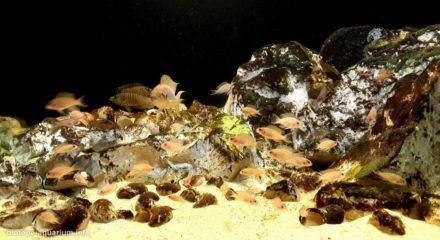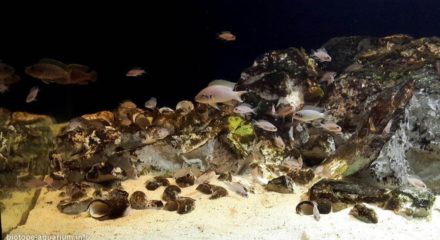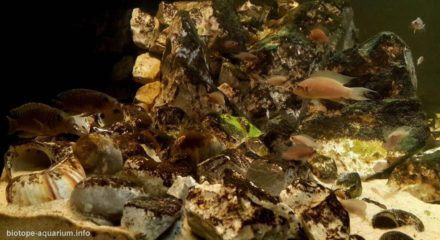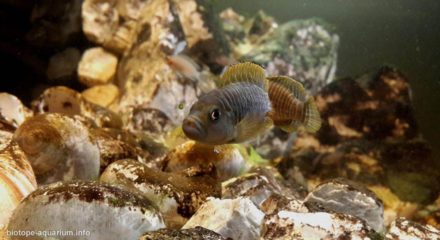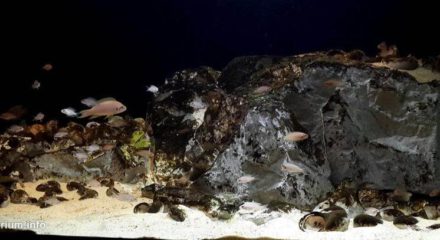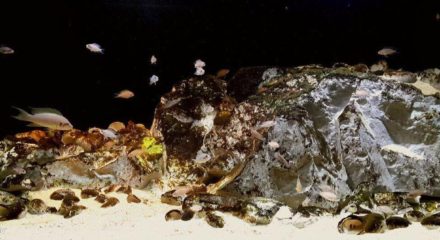Depth water of Congo area, East of Lake Tanganyika, Africa
53rd place in Biotope Aquarium Design Contest 2016
![]() Turkey. Fatih Bolat
Turkey. Fatih Bolat
Aquarium Volume: 200 L
Fish and invertebrates: Neolamprologus brichardi, Neolamprologus similis
Plants list: None
Biotope description: The name Lake Tanganyika alone inspires visions of intrepid explorers and ancient trade routes through the heart of Africa. At 640 kilometers in length and over 1,400 metres at its deepest point; almost 1/6th of all the surface fresh water on earth is contained in this astounding lake. Lake Tanganyika is bounded by 4 countries: Burundi in the north, Tanzania and DR Congo in the east and west and Zambia in the far south, centuries of trade and travel along the lake have resulted in a mix of cultures derived from as far away as Arabia and people on the lake have more in common with each other than their respective and relatively new “home countries”. Congo area is east side of Lake Tanganyika. In Shores of Congo have got frequently rocky habitats. After than 25mt deep you can see the place where begin the sandy areas. There are many shells which is host of different Lamprologus species. These species live in the them and use this shells to hide from predators. Also they carry them with their mouth to different places. Females spawn their eggs into them.Their unique behavior is associated with their affinity to shells. They burrow sand to move shells, take refuge in shells and also breed in them. They have pale white coloring with black vertical bars running the length of their bodies. The species is sexually monomorphic, meaning sexing individuals is extremely hard or impossible based on external appearance alone (although size separates them when fully adult). The temperature change from 26°C up to 28°C. PH 7.8-9.0, GH: 160-322, KH 179-240, Nitrite: 0, Ammonia: 0.
Fish and invertebrates: Neolamprologus brichardi, Neolamprologus similis
Plants list: None
Biotope description: The name Lake Tanganyika alone inspires visions of intrepid explorers and ancient trade routes through the heart of Africa. At 640 kilometers in length and over 1,400 metres at its deepest point; almost 1/6th of all the surface fresh water on earth is contained in this astounding lake. Lake Tanganyika is bounded by 4 countries: Burundi in the north, Tanzania and DR Congo in the east and west and Zambia in the far south, centuries of trade and travel along the lake have resulted in a mix of cultures derived from as far away as Arabia and people on the lake have more in common with each other than their respective and relatively new “home countries”. Congo area is east side of Lake Tanganyika. In Shores of Congo have got frequently rocky habitats. After than 25mt deep you can see the place where begin the sandy areas. There are many shells which is host of different Lamprologus species. These species live in the them and use this shells to hide from predators. Also they carry them with their mouth to different places. Females spawn their eggs into them.Their unique behavior is associated with their affinity to shells. They burrow sand to move shells, take refuge in shells and also breed in them. They have pale white coloring with black vertical bars running the length of their bodies. The species is sexually monomorphic, meaning sexing individuals is extremely hard or impossible based on external appearance alone (although size separates them when fully adult). The temperature change from 26°C up to 28°C. PH 7.8-9.0, GH: 160-322, KH 179-240, Nitrite: 0, Ammonia: 0.

